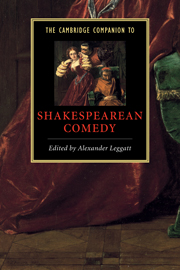Book contents
6 - Forms of confusion
from Part 2 - Shakespearean comedy
Published online by Cambridge University Press: 28 May 2006
Summary
Drama makes a ceremony out of a muddle. Much of the world's theatre originated in seasonal festivals, rites of fertility and initiation, and forms of liturgy. It still retains a ceremonious quality, with performers and audience responsive to conventions of conduct. Yet the subject of drama is confusion: whether evoking horror or hope, drama gives shape to the disarray and precariousness of our lives. Accordingly, the word confusion is one which Shakespeare explores. While he uses it most often in the root meaning of ruin or perdition (OED, sense 1), he also employs most of the other senses then current: putting to shame (sense 2); mental perturbation, embarrassment (3); the 'confusion of tongues' at the tower of Babel (4); the now standard meaning of disorder (5); tumult and commotion (6); and finally conflation, or the 'con-fusion' of intimate mingling and blending (7). He also delights in the possibilities of the word. When Launcelot Gobbo is teasing his old father, he says, “I will try confusions with him” instead of “try conclusions” or make an experiment (The Merchant of Venice, 2.2.37). When out hunting, Theseus and Hippolyta relish “the musical confusion / Of hounds and echo in conjunction” (A Midsummer Night's Dream, 4.1.110-11), an echoing confusion of senses 5, 6, and 7. When Hymen comes to resolve the enigmas of Rosalind with “Peace ho! I bar confusion” (As You Like It, 5.4.125), he gives his statement a comprehensive finality by blending senses 3, 5, and 6. Friar Lawrence insists on the irrelevance of histrionic outpourings of grief at Juliet's apparent death by juxtaposing senses 1 and 6: “Peace ho, for shame! Confusion's [cure] lives not / In these confusions” (Romeo and Juliet, 4.5.65-66).
- Type
- Chapter
- Information
- The Cambridge Companion to Shakespearean Comedy , pp. 81 - 101Publisher: Cambridge University PressPrint publication year: 2001



